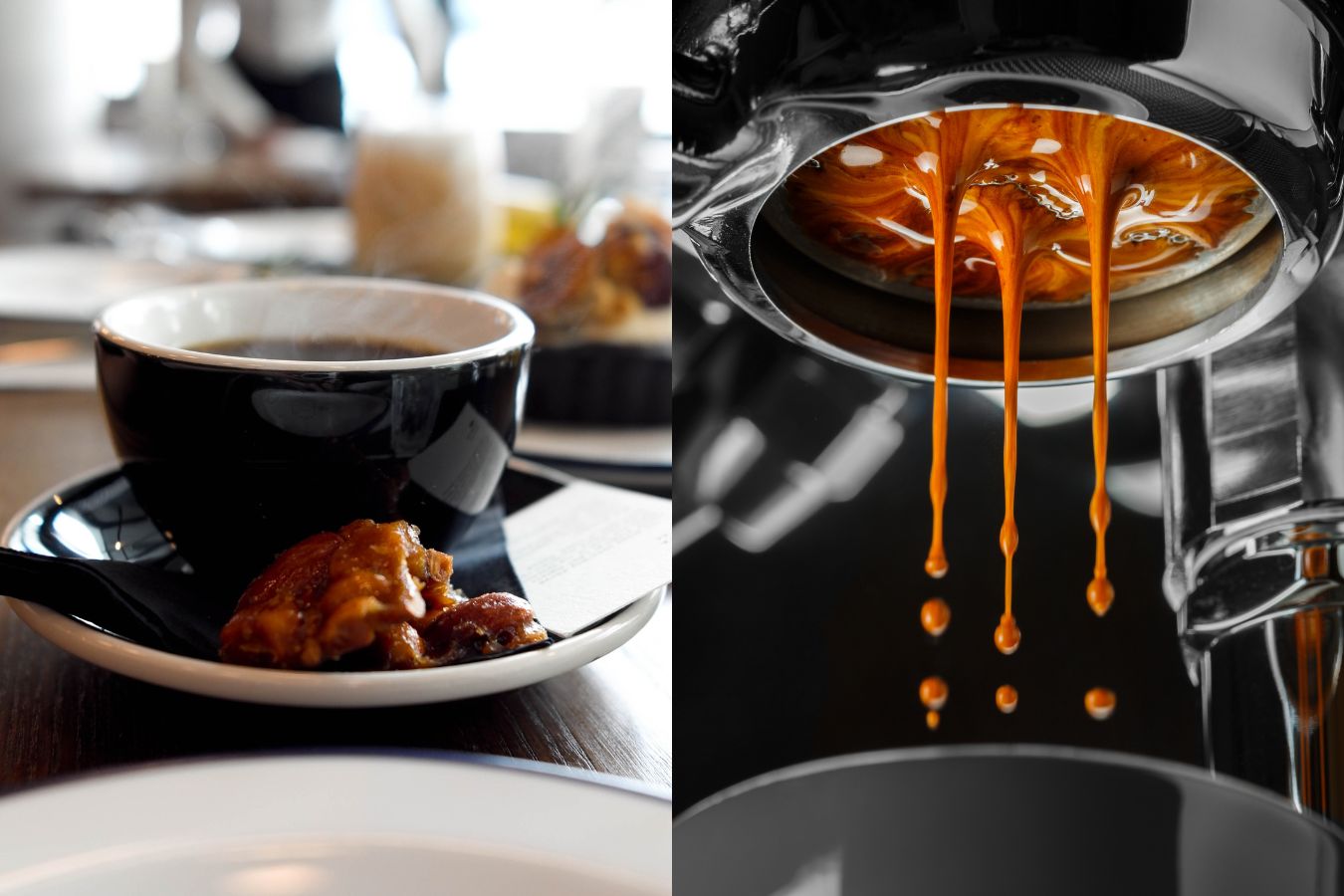Discovering the Rich Flavors of Coffee Beans: a Deep Dive Into Espresso and Blended Coffee Beans
When you explore the rich tastes of coffee beans, you reveal an intricate globe where each range brings its very own character to your cup. Understanding the origins, refining techniques, and roasting techniques can transform your coffee experience. As you browse via the art of coffee and the imagination behind blended coffees, you'll start to value the subtleties that make each sip unique. What you'll discover following could alter the way you appreciate your morning mixture.
The Beginnings of Coffee Beans: Checking Out Terroir and Flavor Profiles
When you take a sip of coffee, you're not simply enjoying a beverage; you're experiencing a rich tapestry of tastes formed by the beans' origins. Each area generates distinct taste profiles affected by elevation, climate, and dirt. Beans from Ethiopia commonly burst with brilliant, fruity notes, while those from Colombia often tend to provide a well balanced, nutty sweetness.
As you check out various origins, you'll observe exactly how terroir-- the ecological aspects affecting a plant-- plays a vital function - Single Origin Espresso. The very same coffee variety can taste dramatically different relying on where it's grown
When you think about these variables, you start to appreciate the intricacy behind your mug. Each sip tells a story of the land and the farmers who supported the beans. Following time you indulge, believe regarding the trip your coffee took prior to it reached your hands, and appreciate those detailed tastes that reflect its beginning.
Comprehending Coffee: The Art and Scientific Research Behind the Mixture
When you think of espresso, it's not almost the strong taste; it's additionally concerning the methods that bring it to life. Understanding how different prep work approaches effect taste can transform your brewing experience. Let's explore the intricacies of coffee prep work and discover the distinct flavor accounts that make each mug unique.
Espresso Preparation Strategies
Coffee preparation is both an art and a science, incorporating exact strategies with a deep understanding of coffee. To start, you'll want to pick top quality, fresh baked beans and grind them finely for perfect extraction (Single Origin Espresso). The grind dimension is crucial; as well crude, and your espresso will certainly be weak, as well fine, and it'll be bitter
The outcome needs to be a rich, luscious espresso with a beautiful layer of crema on top. With practice, you'll understand these techniques.
Flavor Accounts Discussed
The world of espresso uses a rich tapestry of flavor profiles that can elevate your coffee experience. Light roasts typically display bright level of acidity and lively flavors, while dark roasts present deeper, bolder tones.
A well-crafted blend might balance the bright notes of an Ethiopian bean with the abundant, chocolatey undertones of a Brazilian bean. Embrace the trip of uncovering espresso's diverse tastes, and you'll transform your coffee ritual right into an exciting adventure.
Handling Methods: Exactly How They Impact Taste and Scent
While it might appear that the origin of coffee beans is one of the most substantial factor in determining their flavor and scent, the handling techniques made use of post-harvest play a similarly important duty. You'll discover that these approaches can dramatically change the final taste account of your cup.
For example, the washed process removes the fruit from the beans prior to fermentation, commonly bring about a cleaner, brighter flavor. The natural procedure leaves the fruit intact throughout drying out, resulting in a sweeter, fruitier account.
Other approaches, like honey handling, strike an equilibrium, enabling some fruit mucilage to stay, supplying an one-of-a-kind complexity.
Each processing method connects with the beans' intrinsic qualities, boosting or silencing certain flavors and fragrances. So, when you drink that espresso or mixed coffee, bear in mind that the journey from cherry to mug is influenced not simply by beginning however likewise by exactly how those beans were refined.
Toasting Methods: Unlocking the Complete Prospective of Coffee Beans
Roasting strategies are vital for disclosing the full capacity of coffee beans, as they transform raw, environment-friendly beans right into the fragrant, savory coffee you take pleasure in. The selection of roasting approach-- light, medium, or dark-- significantly influences flavor profiles. Light roasts protect the beans' all-natural level of acidity and fruity notes, while medium roasts equilibrium sweetness and richness. Dark roasts, on the various other hand, stress vibrant, smoky tastes.
You can trying out roasting times and temperature levels to locate your perfect mixture. A slower roast at reduced temperature levels allows for complicated tastes to develop, while a quicker roast can magnify resentment. Focus on the splits during toasting; the initial crack suggests a light roast, while the second fracture signals a dark roast. By grasping these techniques, you'll reveal a world of taste, raising your coffee experience to brand-new heights. Take pleasure in every sip, recognizing the care that went right into your cup!
The Magic of Blended Coffee: Creating Special Taste Experiences
Developing an one-of-a-kind taste experience with combined coffee can change your morning routine right into an expedition of taste. By integrating various beans from different regions, you can reveal a symphony of tastes that boost your mug to new try this out elevations. Each mix deals a distinctive profile, stabilizing level of acidity, body, and sweetness to develop something really special.
When you choose a blend, you're not simply selecting a coffee; you're selecting a journey throughout varied landscapes and cultures. Trying out various combinations allows you to discover your individual favorites, whether you enjoy fruity notes or abundant, chocolatey touches.

Tasting Notes: Identifying the Subtleties in Your Cup
As you drink your coffee, you might discover a range of flavors dancing on your palate, each revealing the ins and outs of the beans. You might taste the bright acidity reminiscent of citrus or the deep, abundant notes similar to dark chocolate. The sweetness can stimulate honey or caramel, balancing the total account wonderfully.
Pay attention to the body of the coffee-- does it really feel light and ventilated, or is it complete and velvety? The coating, too, supplies hints; a sticking around aftertaste might mean nuttiness or flower undertones.

Do not fail to remember to discover the one-of-a-kind qualities of different beginnings, as each region presents distinctive flavors - Single Origin Espresso. For example, Ethiopian coffees frequently present fruity notes, while Colombian beans may showcase an extra rounded sweet taste. By identifying these nuances, you'll strengthen your recognition for every cup, boosting your coffee experience to brand-new elevations

Brewing Approaches: Optimizing Flavor Removal for every single Bean
When you discover the numerous developing approaches, you'll uncover that each technique can considerably influence the taste account of your coffee. From French press to pour-over, each technique extracts various compounds, enhancing or muting particular notes. Using a French press enables oils to continue to be in the mixture, creating a richer taste, while pour-over stresses clearness and brightness.
Temperature and grind dimension additionally play necessary duties. A coarser work functions best for chilly mixtures, while a great grind is suitable for espresso. Trying out water temperature level-- in between 195 ° F and 205 ° F-- can reveal covert flavors, also.
Do not fail to remember about steeping time; a fast removal can cause sour notes, while over-extraction may generate bitterness. By readjusting these variables, you can take full advantage of taste removal and genuinely elevate your coffee experience. Enjoy the trip of uncovering what method finest suits your taste buds!
Frequently Asked Concerns
What Is the Ideal Water Temperature for Developing Coffee?
The suitable water temperature for brewing coffee's between 195 ° F and 205 ° F. If you use water that's as well hot, you'll over-extract tastes; as well cold, and you will not extract enough. Goal for that wonderful area for the very best mixture!
Exactly How Does Grind Size Affect Coffee Taste?
Grind size considerably influences coffee flavor. Finer grinds extract much more tastes and oils, causing a bolder preference, while coarser grinds yield a lighter flavor. Readjusting grind size aids you achieve your wanted coffee account.
Are There Health Advantages Surrounding Drinking Coffee?

What Is the Difference Between Arabica and Robusta Beans?
Arabica beans are smoother and sweeter, usually featuring fruity flavors, while robusta beans Get More Information are more powerful with a bitter taste and greater caffeine content. You'll observe these distinctions in scent and developing experience.
How Can I Store Coffee Beans for Freshness?
To save coffee beans for freshness, keep them in an airtight container, away from moisture, heat, and light. You'll preserve their flavor much longer if you just grind what you require right before developing.
Discovering the Abundant Tastes of Coffee Beans: a Deep Dive Into Espresso and Blended Coffee Beans.
When you explore the abundant flavors of coffee beans, great post to read you reveal a complicated globe where each variety brings its very own personality to your cup.When you take a sip of coffee, you're not just taking pleasure in a drink; you're experiencing a rich tapestry of flavors shaped by the beans' origins.Roasting techniques are vital for revealing the complete capacity of coffee beans, as they change raw, environment-friendly beans right into the aromatic, delicious coffee you appreciate.As you drink your coffee, you may discover a spectrum of flavors dancing on your taste buds, each disclosing the complexities of the beans.